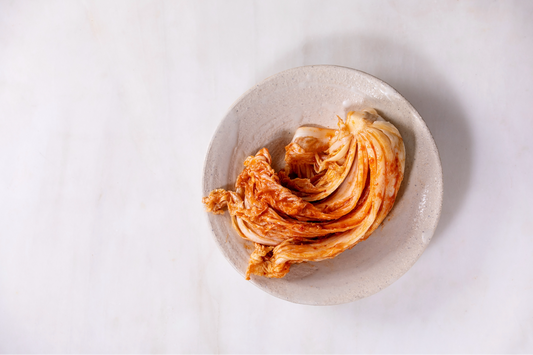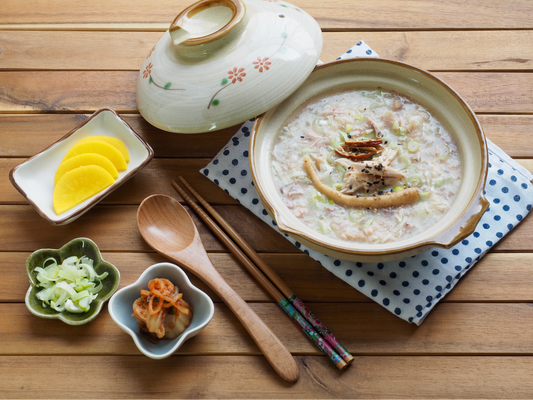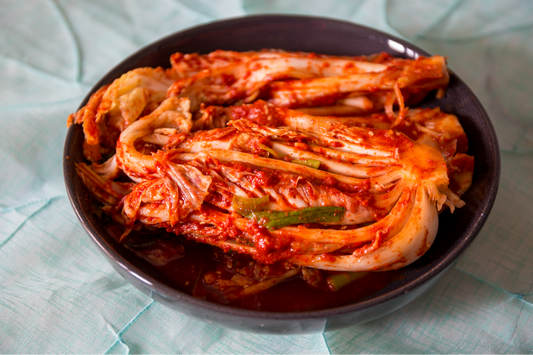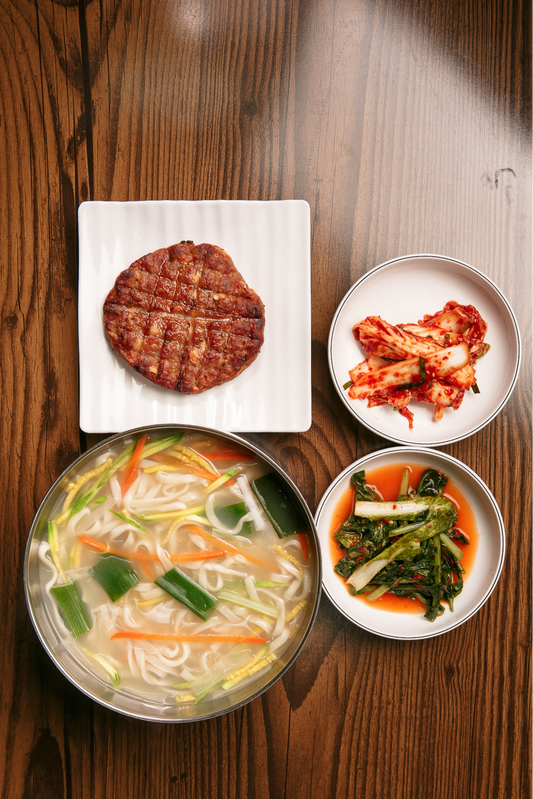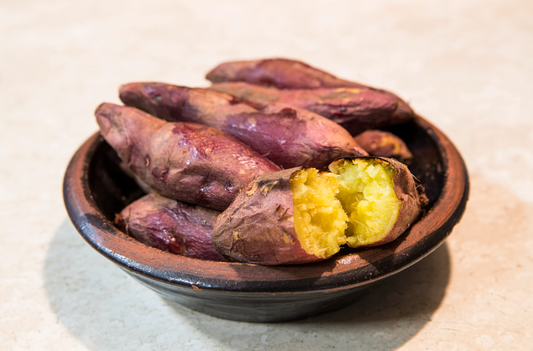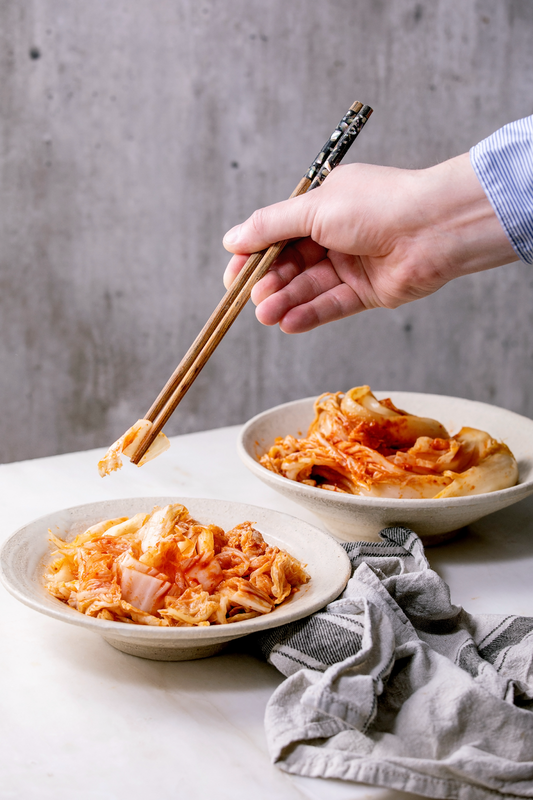Potatoes, Samgyeopsal, Juk, and Bibimbap: Enjoying Various Korean Dishes with Kimchi(part1)

Have you thought about kimchi's part in Korean dishes? It's not just a side dish. It plays a big role in making each meal special. From hot stews to barbecued meat, kimchi adds a unique taste. Korean cuisine stands out for its daring flavors. It's a blend of old traditions and new tastes. The many types of kimchi highlight Korea's rich food culture. They make every dish more exciting, telling tales of Korea's heritage.
Let's dive into Korea's flavors, where kimchi's spicy and sour notes meet the savory taste of classic dishes. Think samgyeopsal, juk, and bibimbap. By exploring these combinations, we learn about Korean cuisine's depth. We see how fermented foods balance with other dishes, for a unique eating experience.
Key Takeaways
-
The harmonious integration of kimchi with a variety of popular Korean dishes.
-
Understanding the sensory interplay between fermented foods and traditional Korean cuisine.
-
Diverse Korean culinary practices that go beyond kimchi to include dishes like samgyeopsal.
-
Tips on how to best enjoy Korean favorites with the zest of kimchi – from breakfast porridge to rich barbecues.
-
Insights into how Korean cuisine remains rooted in its cultural legacy while dynamically evolving.
-
Exploration of affordable, authentic Korean meal options – like a 5,000 Won sack of homemade kimchi.
-
The extraordinary variety of Korean dishes, from spicy stir-fried octopus to refreshing cold noodle soups.
Potatoes: The Simple and Savory Pairing with Kimchi
The flavor harmony of potatoes and kimchi shows how these foods work well together. Korea's culinary history is rich with both. Potatoes, or gamja, soak up kimchi's bold flavors well. This combo makes a meal that's both simple and deeply satisfying.
Consider the Kimchi Potato Salad with Yukon Gold potatoes. These potatoes are known for their creamy texture. When mixed with tangy kimchi, the result is a flavorful dish. A creamy dressing with mayo, gochujang, Dijon mustard, and sesame oil brings it all together perfectly.
Kimchi pancakes are another great example of this flavor harmony. Grate potatoes and mix them with kimchi, egg, and potato starch. This makes them great as a snack or side dish. They get a nice golden crust when fried in a neutral oil, which tastes great with the spicy kimchi.
In these dishes, the ingredients show off how versatile and nutritious the potato and kimchi pairing can be. Together, they create delicious flavors and are good for you too. They're rich in vitamins A and C, potassium, and fiber. Each bite brings comfort and the spicy taste of Korean home cooking into your kitchen.

The Taste and Characteristics of Potatoes
Potatoes play a big role in Korean food. They show how versatile and tradition-rich these tubers are worldwide. The soft and earthy flavors make them a key part of many Korean dishes.
Description of the soft, earthy flavors of boiled or roasted potatoes
Roasted potatoes, like the Maris Piper type, are loved for their fluffy inside and crispy outside. This texture goes well with the tangy taste of kimchi. When cooked in chicken stock and goose fat, they get a golden-brown look that's tasty and appealing.
This cooking method brings out the best flavor. It also pairs well with strong flavors like kimchi, a common item in Korean homes.
Potatoes in Korean cuisine are more than just tasty. They're a way to hold onto cultural heritage through food. By adding kimchi salt to potatoes, it shows a food culture that is growing yet respects its history. Using goose fat helps roast the potatoes just right, making them a joy to eat.
Traditional Korean dishes show how important simplicity and good ingredients are. Mixing potatoes' subtle taste with kimchi's strong flavor creates a special dining experience. It connects the food to Korean cooking traditions.
Flavor Balance Between Potatoes and Kimchi
The simple taste of potatoes and the spicy zing of kimchi create an amazing flavor harmony of potatoes and kimchi. This mix is a thoughtful choice that brings out the best in both foods. Potatoes provide a gentle, cozy flavor, making them the ideal backdrop for kimchi's bold taste.
How kimchi's spice and acidity add a vibrant contrast to the simple taste of potatoes
Kimchi brings excitement to the usual pairing with potatoes in a kimchi with traditional Korean dish pairing. Its acidity and spiciness break through the potato's starchiness, adding refreshing and intricate flavors. This balance is not just pleasing but key to making satisfying, well-rounded dishes.
Adding to this, the mix of crunchy kimchi and soft potatoes offers a unique eating experience. This approach shows the thoughtfulness in Korean cooking, where each ingredient is essential for the dish's final flavor and look. The combination of these ingredients showcases the richness and creativity of Korean food traditions.

Tips and Recipe for Pairing Potatoes with Kimchi
Diving into the Korean cuisine pairings, potatoes and kimchi create a unique mix. This combination is both comforting and full of zest, ideal for daily meals. Let’s explore an easy kimchi with potatoes recipe to broaden your cooking skills.
Suggestions for Enjoying Potatoes with Kimchi as a Snack or Side Dish
First, let's make mashed potato kimchi pancakes. They are creamy, spicy, and easy to prepare. It's a great choice for a quick snack or a distinctive side dish.
Total Preparation and Cooking Time: 20 minutes
Serves: 2
Here's what you'll need:
-
1 cup of leftover mashed potatoes
-
1/4 cup of finely chopped kimchi
-
3-4 slices of white or brown day-old bread, crumbled
-
1/4 cup of rice meal (additional for dusting)
-
2-4 tablespoons of canola oil for shallow frying
-
A few dashes of Tabasco sauce, for serving
-
1-2 tablespoons of pumpkin seeds for garnish
-
Seasonings: 1/4 teaspoon thyme, 1/2 teaspoon salt (adjust based on the saltiness of your potatoes and kimchi), and 1/4 teaspoon cayenne pepper (optional)
-
1/2 cup of finely chopped red or white onion
Start by mixing mashed potatoes with kimchi, bread crumbs, onion, thyme, cayenne, and salt. Shape the mix into small patties and coat with rice meal. Fry them in a skillet until both sides are golden. Enjoy them warm, topped with pumpkin seeds and Tabasco sauce for extra flavor.
This recipe is not just tasty but shows how kimchi with potatoes can be a cozy yet thrilling dish. The mix of earthy potatoes and spicy kimchi brings a perfect balance. It's a great introduction to Korean cuisine pairings, for newcomers and enthusiasts alike.

Samgyeopsal: The Rich Flavor of Grilled Pork Belly with Kimchi
The dynamic flavors of grilled samgyeopsal with kimchi are essential to Korean food. This dish uses rich pork belly cuts cooked on a grill. It is served with tangy and spicy kimchi. Together, they create a memorable balance of richness and spice.
To make perfect grilled samgyeopsal at home, start with 2 pounds of pork belly. This will serve about four people. It should be grilled for 5 to 7 minutes. This makes the outside crispy while keeping the inside juicy. Adding garlic and toasted sesame oil enhances the flavors.
With the pork, serve various fresh greens like Little Gem, endive, or perilla. These add a refreshing crispness. Pa muchim, a zesty scallion salad, goes well with the kimchi and samgyeopsal. It adds a lively flavor to the meal.
Mix 1 tablespoon of honey with the same amount of doenjang for the marinade. This balances the saltiness with sweetness, making the pork taste better. Serve with steamed white rice. It balances the spicy and garlicky flavors of the dishes.
The samgyeopsal and kimchi harmony is more than just a meal. It's about enjoying grilling and sharing with others. This dish is not only good for the stomach but also for the soul. It embodies the community spirit and bold tastes of Korean cuisine.
The Taste and Characteristics of Samgyeopsal
In the world of Korean BBQ dishes, samgyeopsal is a true gem. It's famous for its rich taste and crispy texture. As a key part of Korean food, this grilled pork belly offers a simple but rich flavor. It becomes even tastier with kimchi, adding a zesty kick.
Overview of the rich, fatty flavor of grilled pork belly and its crispy texture
Samgyeopsal is loved for its fatty content. When grilled, the fat melts, creating a deep, mouthwatering flavor. The sound of it cooking is part of the fun. The crispy outside and tender inside make it a Korean BBQ favorite.
In Korea, pork belly slices come in various thicknesses. Specialty shops sell thin slices for $7 to $13 per pack. These are great for getting a crunchy sear. When cooked plain, a little salt, sesame oil, or ssamjang brings out its natural tastes.
Samgyeopsal is often served with many side dishes. Fresh perilla leaves, Korean green chili pepper, and various salads like seasoned spinach boost the meal's flavor. They offer a refreshing contrast to the meat's richness.
Koreans don't just enjoy samgyeopsal for its taste. It's a key part of summer celebrations and gatherings. Its versatility, from wine marinades to charcoal grilling, showcases Korea's rich culinary culture.

Flavor Harmony Between Samgyeopsal and Kimchi
In the delightful world of Korean cuisine, samgyeopsal and kimchi make a perfect pair. The richness of grilled pork belly pairs well with kimchi's zest. This combo delights the palate and showcases deep flavors in kimchi with traditional Korean dishes.
How kimchi's spice cuts through the richness of samgyeopsal, creating a balanced taste
Kimchi brings spice and tang to the fatty samgyeopsal, making each bite delicious. The samgyeopsal kimchi recipe is loved for this balance. Crispy samgyeopsal and spicy kimchi make a mix that tempts and satisfies.
Trying different kimchis, like baechu (Napa cabbage) or kkakdugi (radish kimchi), adds variety. Each kimchi type complements the pork belly differently, enhancing the meal.
This pair isn't just tasty; it's also balanced in diet. Kimchi's probiotics aid digestion, making the rich samgyeopsal easier to enjoy. This mix is popular in Korean gatherings for its taste and health benefits.
The lasting love for samgyeopsal and kimchi shows a deep understanding of their flavors. At home or out, this pairing is a tribute to Korean culinary tradition.

Tips and Recipe for Pairing Samgyeopsal with Kimchi
Mastering the samgyeopsal and kimchi pairing guide starts with learning to cook samgyeopsal right. To get that crispy outside and juicy inside, grilling it properly is key. Start on medium-high heat, letting the fat render and the meat brown without burning. It should take about 15 minutes to get the pork belly just right.
Grilling Techniques and Accompaniments
For the perfect Korean BBQ cooking experience, you can use portable gas burners or electric grills. These options often come with features to drain fat, reducing smoke indoors. Using wood charcoal adds a unique flavor, but it's not a must.
Pair your samgyeopsal with different kinds of kimchi. You can try classic spicy cabbage or milder choices, like yeolmumul kimchi. Enhance the meal with ssamjang (spicy sauce), sliced garlic, and sesame oil to bring out all the flavors.
Try wrapping the pork in lettuce or perilla leaves. Add garlic, ssamjang, and a bit of rice for a mix of crunchy, meaty, and spicy tastes. This method shows off the harmony of flavors and the fun of Korean meals.
Don't forget side dishes like Korean soybean stew or steamed egg with your samgyeopsal. They balance the hearty flavors for a truly filling meal. These additions make any Korean BBQ night or simple dinner authentic and enjoyable.
Lastly, ensure your kitchen is well-ventilated and the table is protected with disposable covers. This makes clean-up easier, letting you focus on enjoying the meal rather than the mess.




